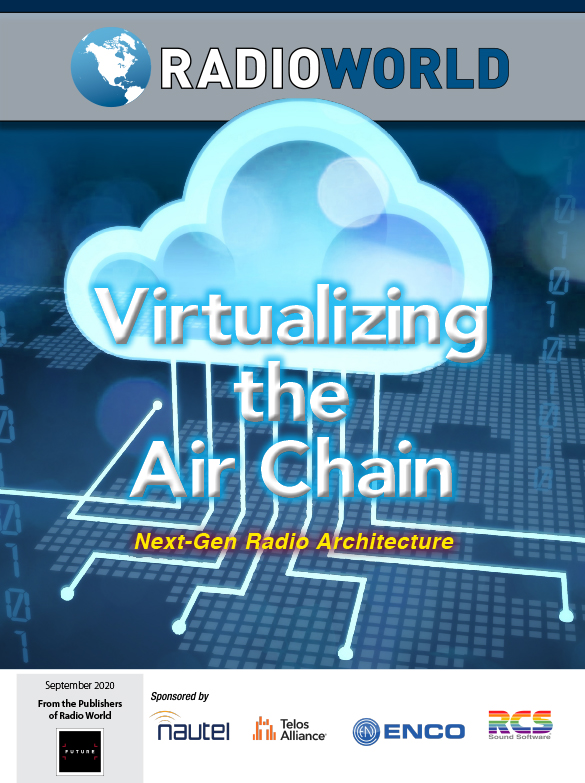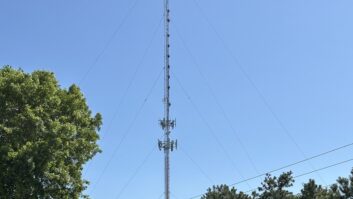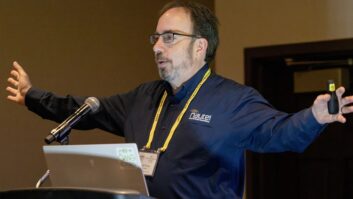One in a series of commentaries about how radio’s technical infrastructure will look in the future.
Michael LeClair is chief engineer of WBUR Boston and former tech editor of RW Engineering Extra.
I recently moderated a roundtable interview with five leading technologists for the Radio World ebook “Virtualizing the Air Chain.”

We discussed whether the industry is ready for a fully virtual air chain, what kind of obstacles exist, and the implications for radio managers and their suppliers including a discussion of cap-ex vs. op-ex philosophies. You can read that very interesting discussion at radioworld.com/ebooks.
Radio World’s Editor in Chief Paul McLane then posed a related question to me: “All this is happening in an industry that, at least in the United States, suddenly is not required to maintain a physical studio in every city of license,” he asked.
“This combined with the possibilities in virtualization seems to open some pretty remarkable implications for what a studio air chain looks like in a few years. Am I right in thinking that this is an important angle to this story?”
I replied, and Paul asked me to share my thoughts with readers.
Stretching the meaning
Yes, there’s an angle there; and the engineers in our ebook roundtable were clearly coming from groups that all would find that angle to their advantage.
But I note that satellite distribution already has consolidated the studio into one location if desired.
The removal of the main studio rule simply codifies the lack of having any presence in a particular market that is associated with their license, except the physical transmitter and their EAS monitoring.
Stations had already been stretching the meaning of the main studio rule for years of course, both in the commercial and NCE worlds. With music automation, we’re already at the point where the studio portion of the radio station has been virtualized into computers and it happened a long time ago.
To take EMF and Cox as examples, they appear to be well along in building out the centralized “cloud” infrastructure, but not in the commonly understood sense of moving all their infrastructure into the hands of someone like Amazon, which handles web services for all kinds of web-based businesses
Neither appears to be enthused about the idea of moving their air chain content into a rented site with IT support, no matter how good it is. They are going to model their centralized IT operations like a content distribution site. They may even purchase the support for it if the price is right (as in the concept of “hybrid cloud” that we discuss in the ebook).
But they don’t seem on a track to ditch all their assets and rent them from suppliers whose primary expertise is web site hosting. For the multiple streams and formats they generate, it could all be done in one location and then spread out across the country to fill in at a selection of stations that works for them. Assembly of localized advertising could be done over the web from anywhere.
Much of what is streaming on the web has been shown to be aimed at listeners to legacy programming from radio stations. The volumes there are so large that most (if not all) large streamers have already moved to the model of renting out capacity from a CDN, a content distribution network. The station creates a stream they hand off to the CDN, and the CDN arranges the necessary parts and pieces like different versions of the stream (higher or lower bitrate), ad insertion and variable bandwidth upon demand to support a changing number of listeners. Individual stations don’t really have to do much except hand off the content and that could be coming from or going to anywhere in the continental United States.
Creating live content would still require a studio somewhere — I’m imagining a large and uninteresting warehouse somewhere in the Midwest with 40 voice booths, cranking out the announcer bits and producing local ads when needed. Add in music assembly by automation at the CDN and you are ready to build as many feeds as you need for the broadcast side, using a few successful templates as a start.
Cloud thinking
I would argue that we’ve already reached this model with existing distribution networks and there’s really nothing new there.
The new part of the discussion is the idea of moving all the other aspects of the air chain that might normally reside at a transmitter site into this common studio for assembly so that a single stream could be deployed to meet the unique characteristics of a particular station: HD, multicast variations, processing, PPM, RDS metadata, HD PAD and EAS insertion.
On the other hand, as Alan Jurison of iHeart said during our roundtable, this might be an attractive option to smaller broadcast groups or ones that serve low population areas that have limited local advertising revenue available.
In order to get 24/7 support they might want to build the automation and the rest of the chain in an actual cloud center, then ship it off to the transmitter. As Philipp Schmid of Nautel said: All you need is an Ethernet jack and you’re all set.
But it’s true that the pandemic has moved our entire industry into learning the techniques required to assemble a broadcast program largely, if not entirely, from home. These newly learned skills would be at the core of transitioning the industry further to a centralized data center model.
What do you think the radio air chain of the future looks like? Email [email protected] with “Letter to the Editor” in the subject field.






